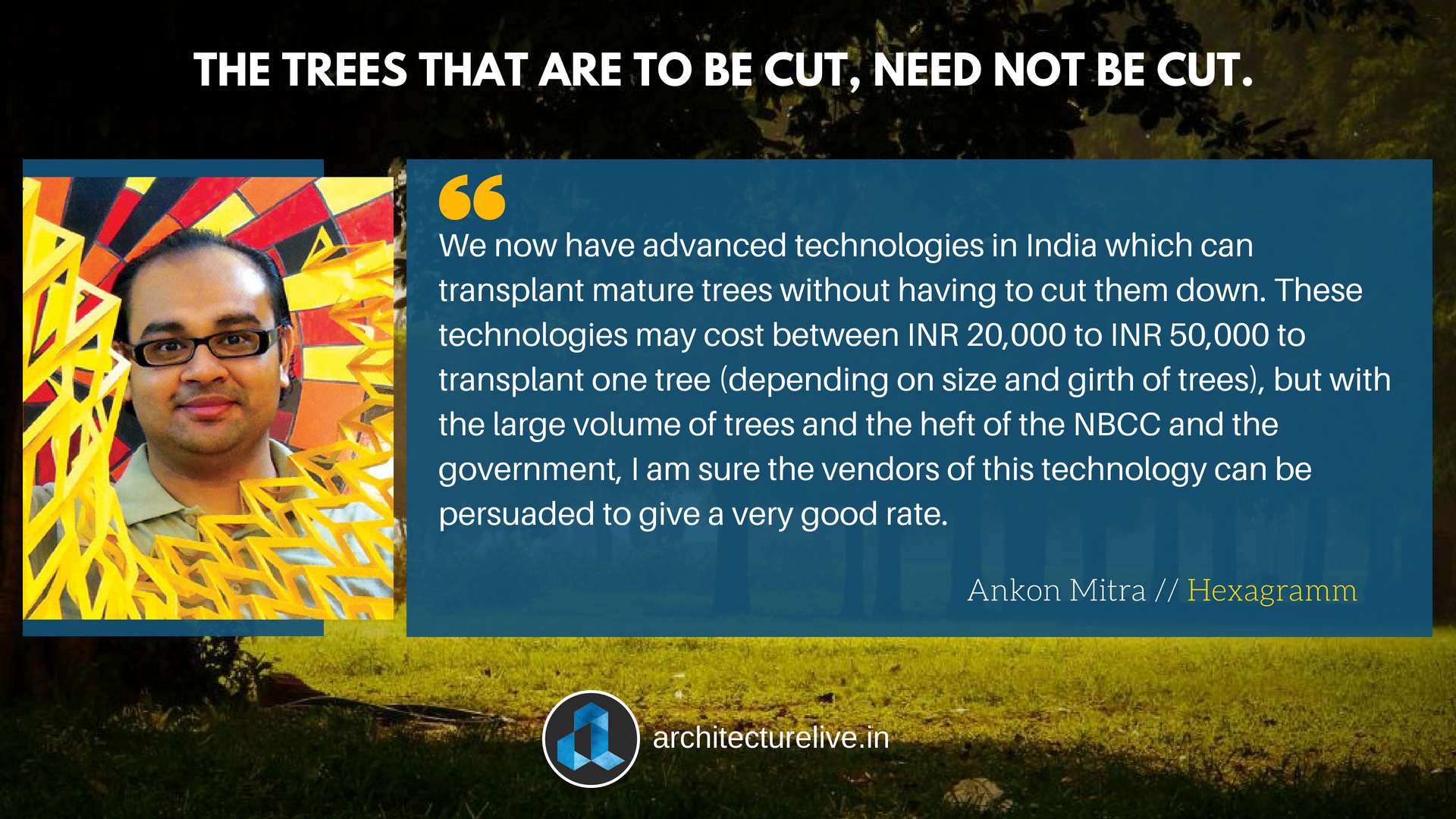There have been widespread protests against the government’s decision to cut nearly 16500 trees for the redevelopment project. Ministry of Housing and Urban Affairs came up with a press release that promised replanting of trees in 1:10 ratio. Which means for every single tree that would be cut, there would be ten new saplings planted. Ankon Mitra, who is a landscape architect with 15 years of experience, popular for his “Oritecture“ has written to the PMO and Ministry of Environment, Forests and Climate Change requesting them to transplant the trees instead of cutting them.
His full letter below:
Subject : Transplanting 16500 Trees
TO : The Honourable Prime Minister of India – Shri. Narendra Modi
CC : The Honourable Minister of Environment, Forests and Climate Change – Shri. Harsh Vardhan
Dear Prime Minister Sir,
In reference to a news item in the Times of India (Delhi Edition), dated 21st June 2018 (copy of the article is attached), concerning the felling of 16500 mature trees in the development of the old government residential colonies of South Delhi (Sarojini Nagar, Nauroji Nagar etc.), I am writing to appeal to you to please direct the NBCC to transplant these trees instead of felling them. I am an architect and landscape designer with 15 years of landscape design consultancy experience, and I am writing to you as a concerned citizen and an ardent nature lover.
The following points may please be considered –
-
We now have advanced technologies in India which can transplant mature trees without having to cut them down. These technologies may cost between INR 20,000 to INR 50,000 to transplant one tree (depending on size and girth of trees), but with the large volume of trees and the heft of the NBCC and the government, I am sure the vendors of this technology can be persuaded to give a very good rate.
-
The National Solar Mission has helped reduce the cost of solar panels to the extent that it is now economically viable for individual homes and small businesses to buy solar panels. Similarly, a National Tree Transplantation Mission should make this transplantation technology so easily available and widespread – that for all future infrastructure developments in the country (highways, railways, SEZ, factories, urban design master-plan projects, MRT) transplanting trees becomes the norm rather than the exception. It is an expensive proposition right now, but it need not remain so in the future. Thinking about the cost of PV Solar panels now v/s what they were 5-6 years ago, drives home this point very effectively.
-
Planting a 100 saplings in place of one mature tree is not the appropriate answer. It is like saying – the wisdom and knowledge of one grandfather can be replaced by 100 newborn grandchildren. The loss of a mature tree (and its benefits for the environment thereof) is a civilizational scale loss. The word Upanishad means sitting at the foot of a tree (or Master) and gaining wisdom thereof. In India, we have always revered our forests and groves, and the loss of 16500 trees in one go, is an irreparable loss for the climate and ecology of the city of Delhi. New technology can come to the aid of and protect our botanic and ecological heritage. We can create an example of ecological forward looking practices by harnessing our ancient virtues of revering nature and combining that with new world technologies. Development and ecology can and must go hand-in-hand.
-
I must point out that I am not only a lover of nature but also an Architect and a Landscape Designer. However I have no vested financial interest in seeing these transplantation technologies being used. I have no connections or relationship with any vendor or company that offers these technologies. But I have used these technologies in my own landscape design projects and am aware of them from a professional standpoint.
-
I have recently taught a Landscape and Ecology Design module at the Anant National University to the Anant Fellowship postgraduate students, and I had the good fortune of visiting your house and garden on the University premises where I saw the loving care with which the trees are being nurtured in the groves and gardens of the University. I know that you are a lover of trees, nature and forests, and are deeply and spiritually connected to them through your practices of Yoga and meditation. This is also my appeal to you to take this up as a personal project, to see that no infrastructure development project in the country has to ever resort to cutting of trees, especially when such a good technological alternative exists. If necessary, please direct all government agencies to formulate policy guidelines where transplantation becomes the only norm.
-
In this particular instance, NBCC is a very profitable public sector organization and works at very healthy margins. If some of those margins are passed on to the protection and care of nature, they will contribute even more to nation building than they are already doing. I am sure, the new master-plans of these sites already include gardens and landscape areas, and the transplanted trees can be transferred to those future designated landscape areas en-masse, and then those areas cordoned off during the construction process. A lot of these trees can also be transplanted to the Airport, Railway Station upgradation developments in Anand Vihar, New Delhi, Old Delhi, and in parks and avenues throughout the city. Transplantation is a technical and complex process (the roots have to be protected). Even if 70 to 75 percent of the transplanted trees survive, it will be hugely beneficial, rather than seeing all these mature trees put to death forever.
Please do initiate action in this matter. It is a fervent letter of appeal from a very concerned citizen of this country.
Humbly Yours,
Ankon Mitra








